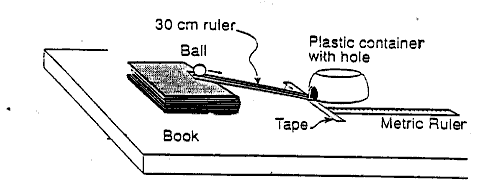Contributed by: New York State Alternative Assessment in Science
Project (NYSED)
Task: At this station, you will be measuring the effect the
height of a ramp has on the distances a ball is able to move a stationary
cup.
Materials:
- 3 books of the same size
- plastic cup or bowl
- ruler with a center groove
- golf ball
- metric measuring tape
- masking tape
- calculator

Directions:
- Be sure your equipment is set up exactly as it appears in the
diagram above. Make sure the cup is placed with the hole facing
the ruler. Rest the ruler on the books at about 5 cm from the
end.
*** The ball must roll into the cup! ***
- Release the golf ball about 2 cm from the top of the wood.
- Measure, in centimeters, how far the ball moved the cup. Be
sure to measure from the front of the cup.
- Record your measurement in the data table on the answer sheet.
- Conduct two (2) more trials for this height. Find the average
of all three (3) trials to the nearest whole number and record
it in the data table on the answer sheet.
- Add one book to the ramp and repeat steps 2-5.
- Add a third book to the ramp and repeat steps 2-5.
- Answer questions 2-5 on your answer sheet.
Answer Sheet
- Record your measurements on the data table below.
Distance cup moved (in centimeters)
|
Number of Books
|
Trial 1
|
Trial 2
|
Trial 3
|
Average
|
|
1
|
|
|
|
|
|
2
|
|
|
|
|
|
3
|
|
|
|
|
- Write a sentence comparing the effect of ramp height on the
average distance the cup moved.
- In terms of energy, explain why changing the height of the ramp
produced different results.
- Was your data the same for all three trials when three books
were used?
____________________________________________
Explain what might have caused this.
- Why does a scientist use more than one trial when conducting
an experiment?
|
|


